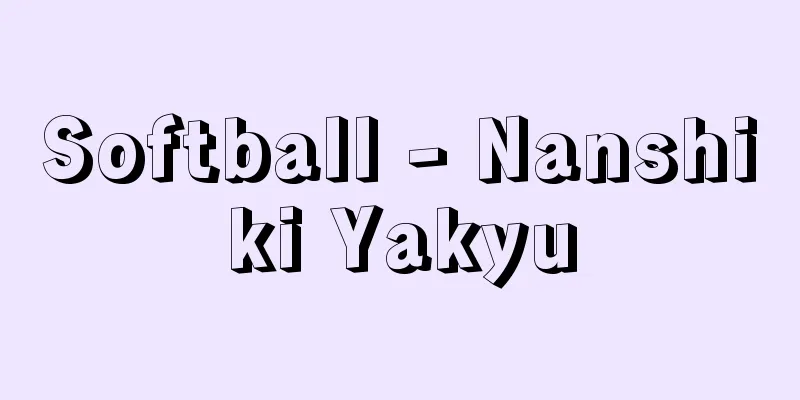Softball - Nanshiki Yakyu

|
A type of baseball unique to Japan that uses a rubber ball. Softball baseball has had a major impact on the development of baseball in Japan. The fact that it is easy to play played an important role in its popularity. It all started in 1919 (Taisho 8) when Itoi Asajiro (a former Kyoto Normal School teacher) invented a less dangerous sponge ball for young boys and used it in baseball games for elementary school students. With the favorable conditions of simple facilities and inexpensive balls, it spread to elementary schools all over the country. As a result, youth baseball flourished, and like middle school baseball, national tournaments were held in both Hanshin and Tokyo. However, this boom in youth baseball came to an end in 1932 (Showa 7) when the Ministry of Education issued an instruction to control student baseball, which prohibited overnight games, closing the way for the improvement of youth baseball. Meanwhile, as youth baseball became more popular, a rubber product manufacturer developed a rubber baseball for young people in 1922 (Taisho 11). This marked the beginning of softball baseball being played not only by young boys but also by adults in general. During World War II, the use of raw rubber was restricted by the Materials Control Order, but the Ministry of Health and Welfare at the time provided special rations of raw rubber to manufacturers, claiming that softballs were necessary to "boost the wartime production drive and increase the physical strength" of the "industrial warriors" working in munitions factories. At the time, baseball was suppressed as an enemy sport, but softball was considered a Japanese-made sport. However, in October 1943 (Showa 18), the second industrial consolidation was put into effect, and production of softballs had to be halted. When the war ended, both student and amateur baseball were still in the process of being rebuilt, and no national unified federation or association had been formed, but the All-Japan Rubber Ball Baseball Federation was formed as early as August 1946, achieving unification of the rubber ball baseball world. The following month, in September, it joined the Japan Amateur Athletic Association (now the Japan Sports Association), and in November of the same year, it was made an official event and competitions were held at the first National Athletic Meet. In the fall of 1986, the All Japan Rubber Ball Baseball Association announced that it had resolved to allow former professional baseball players to return to amateur baseball, something that had not been done by the amateur baseball organizations, the Japan Baseball Federation (for adults) and the Japan Student Baseball Association. In other words, from February 1987, players who had left professional baseball three years ago (one year as of 2008) could participate as players. The number of former professional players registered was limited to a maximum of two for the top-ranked A-class teams, and one for B and C-class teams (two as of 2008), with no restrictions on those over 40 years old, and they could be registered as managers and coaches for junior teams divided into three divisions: elementary, middle, and high school (only elementary and middle school as of 2008). The background to this decision by the federation authorities was that, in line with the global trend of opening up the participation of professionals in amateur sports, the Japan Amateur Sports Association revised its Sports Charter in May 1986 to allow the registration of professional players. The All Japan Rubber Ball Baseball Association is an organization that includes adults (working adults), juniors (junior high school students), and schoolchildren (elementary school students), and as of fiscal year 2017 (Heisei 29), it has a huge number of registered teams, with 49,301. The tournaments it hosts include the Emperor's Cup All Japan Rubber Ball Baseball Tournament, the Takamatsunomiya Cup All Japan Rubber Ball Baseball Tournament, the National Athletic Meet Rubber Ball Competition (all adult divisions), the All Japan Junior Rubber Ball Baseball Tournament (junior division), and the Takamadonomiya Cup All Japan Elementary School Rubber Ball Baseball Tournament (elementary school division), while the tournaments it supports include the National High School Rubber Ball Championship and the National High School Part-time and Correspondence Course Rubber Ball Baseball Tournament. [Junji Kanda, All Japan Rubber Ball Baseball Association] "Illustrated Rules of Softball Baseball, Revised Edition" by Koichi Natori (1999, Seibidoshuppan) [Reference] | |Source: Shogakukan Encyclopedia Nipponica About Encyclopedia Nipponica Information | Legend |
|
ゴム製ボールを使用する日本独特の野球。軟式野球は、日本の野球の発達に大きな影響を与えている。手軽に行うことのできる点が、普及にだいじな役割を果たした。 1919年(大正8)に京都第一高等小学校教員の糸井浅次郎(いといあさじろう)(京都師範OB)が、少年のために危険の少ないスポンジボールを考案して、小学生の野球試合に使用したのが始まりで、簡単な施設と、安価なボールという好条件によって全国の小学校に広まった。その結果、少年野球は隆盛をきわめ、中等学校の野球のごとく全国大会が阪神でも東京でも開催される盛況となった。しかし、この少年野球の隆盛も1932年(昭和7)に文部省から発令された学生野球統制の訓令によって、宿泊を伴う試合が禁止され、少年野球の向上の道は閉ざされた。一方、少年野球の普及に伴い、1922年(大正11)ゴム製品製造元が青年用のゴム製野球ボールを開発した。これが端緒になって、少年に限らず一般の成年までが軟式野球をプレーするようになった。第二次世界大戦中生ゴムが物資統制令によって使用制限になったが、当時の厚生省は、軍需工場で働く「産業戦士」の「戦時生産意欲の向上と体力増強のため」に軟式ボールは必要、としてメーカーに生ゴムを特別に配給した。当時、野球は敵性スポーツとして弾圧されたにもかかわらず、軟式は日本製スポーツとみなされていたのである。しかし1943年(昭和18)10月に至って、第二次企業整備が発動され、軟式ボールの製造は中止のやむなきに至った。 終戦を迎えると、学生野球も社会人野球もいまだ再建の途上にあって、全国的統一組織の連盟も協会も結成をみないときに、早くも1946年8月に全日本軟式野球連盟が結成され、軟式野球界の統一が成し遂げられた。翌月の9月には日本体育協会(現、日本スポーツ協会)に加盟、同年の11月に挙行された第1回の国民体育大会では正式種目とされ、競技が行われた。 1986年(昭和61)秋に全日本軟式野球連盟は、アマチュア野球団体の日本野球連盟(社会人)も日本学生野球協会も手をつけていなかった、元プロ野球選手のアマチュア復帰を認めることを決議したと発表した。すなわち、1987年2月から、プロ野球を退団後3年(2008年現在は1年)を経過した者をプレーヤーとして出場させることができる、としたのである。そして、元プロ選手の登録選手数はトップにランクされるA級チームが最高2人まで、B、C級チームは1人まで(2008年現在は2人まで)で、年齢40歳を超えた者は制限外とし、小学・中学・高校の3部に分かれる少年チーム(2008年現在は小学・中学のみ)には、監督およびコーチとして登録できることにした。連盟当局のこの決断は、アマチュア・スポーツへプロの参加をオープン化する世界的な流れに沿って、日本体育協会が1986年5月にスポーツ憲章を改訂して、プロ選手の登録を認めることにしたのが背景にある。 全日本軟式野球連盟は一般(社会人)、少年(中学生)、学童(小学生)まで包含する団体で、2017年度(平成29)時点の、登録チームの数は、4万9301もある大世帯である。主催大会には、天皇賜杯全日本軟式野球大会、高松宮(たかまつのみや)賜杯全日本軟式野球大会、国民体育大会軟式野球競技会(以上、一般の部)、全日本少年軟式野球大会(少年の部)、高円宮(たかまどのみや)賜杯全日本学童軟式野球大会(学童の部)が、後援大会には、全国高等学校軟式野球選手権大会、全国高等学校定時制通信制軟式野球大会などがある。 [神田順治・全日本軟式野球連盟] 『名取幸一著『図解軟式野球ルール 改訂版』(1999・成美堂出版)』 [参照項目] | |出典 小学館 日本大百科全書(ニッポニカ)日本大百科全書(ニッポニカ)について 情報 | 凡例 |
<<: Nanjinia (English name) African palm civet
Recommend
Forest road - Rindou
This refers to a facility constructed as a traffi...
"Omi Genji Taiheikabuto no Kazari" - Omi Genji Taiheikabuto no Kazari
... Ningyo joruri. There are two pieces with the ...
Anthraquinone sulfonic acid - Anthraquinone sulfonic acid
…The latter method is better for laboratory synth...
Werner syndrome
...However, individuals that have completed their...
royal mercantilism
...The process of change can be broadly divided i...
Avoidance conditioning
...The degree of conditioning can be expressed as...
Auplopus
...Some species build their nests in tree hollows...
Choir
…In the 9th century, a square or rectangular spac...
veṇu (English spelling) venu
…It is made of bamboo and has a simple structure ...
Canary date palm
...Other than this species, the following species...
Sartaqčin (English spelling)
…A term used to refer to the inhabitants of oases...
Calendar Method
A rolling machine with an arrangement of many heat...
Cardinalis Caietanus (English spelling) Thomas De Vio
Italian theologian and philosopher famous as a co...
Paul Celan
A poet of German-Jewish descent. His real name wa...
Liu Ji - Ryuuki (English spelling)
[Raw] Maximum 4 (1311) [Died] Hongwu 8 (1375) Chin...









